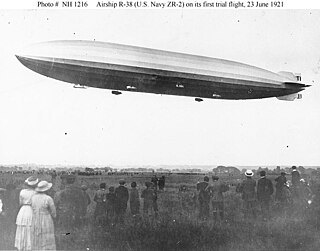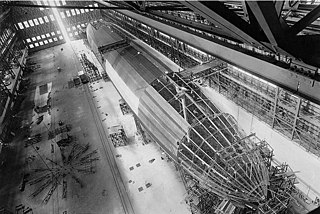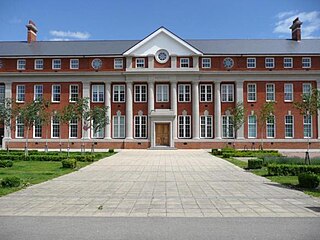Related Research Articles

R101 was one of a pair of British rigid airships completed in 1929 as part of the Imperial Airship Scheme, a British government programme to develop civil airships capable of service on long-distance routes within the British Empire. It was designed and built by an Air Ministry–appointed team and was effectively in competition with the government-funded but privately designed and built R100. When built, it was the world's largest flying craft at 731 ft (223 m) in length, and it was not surpassed by another hydrogen-filled rigid airship until the LZ 129 Hindenburg was launched seven years later.

The R.38 class of rigid airships was designed for Britain's Royal Navy during the final months of the First World War, intended for long-range patrol duties over the North Sea. Four similar airships were originally ordered by the Admiralty, but orders for three of these were cancelled after the armistice with Germany and R.38, the lead ship of the class, was sold to the United States Navy in October 1919 before completion.

His Majesty's Airship R100 was a privately designed and built British rigid airship made as part of a two-ship competition to develop a commercial airship service for use on British Empire routes as part of the Imperial Airship Scheme. The other airship, the R101, was built by the British Air Ministry, but both airships were funded by the Government.

Slide Rule: Autobiography of an Engineer is the partial autobiography of the British novelist Nevil Shute. It was first published in 1954. Slide Rule concentrates on Nevil Shute's work in aviation, ending in 1938 when he left the industry.

Cardington is a village and civil parish in the Borough of Bedford in Bedfordshire, England.

The R.33 class of British rigid airships were built for the Royal Naval Air Service during the First World War, but were not completed until after the end of hostilities, by which time the RNAS had become part of the Royal Air Force. The lead ship, R.33, served successfully for ten years and survived one of the most alarming and heroic incidents in airship history when she was torn from her mooring mast in a gale. She was called a "Pulham Pig" by the locals, as the blimps based there had been, and is immortalised in the village sign for Pulham St Mary. The only other airship in the class, R.34, became the first aircraft to make an east to west transatlantic flight in July 1919 and, with the return flight, made the first two-way crossing. It was decommissioned two years later, after being damaged during a storm. The crew nicknamed her "Tiny".

The Rolls-Royce Condor aircraft piston engine is a larger version of the Rolls-Royce Eagle developing up to 675 horsepower. The engine first ran in 1918 and a total of 327 engines were recorded as being built.

A rigid airship is a type of airship in which the envelope is supported by an internal framework rather than by being kept in shape by the pressure of the lifting gas within the envelope, as in blimps and semi-rigid airships. Rigid airships are often commonly called Zeppelins, though this technically refers only to airships built by the Luftschiffbau Zeppelin company.
Vickers Limited was a British engineering conglomerate. The business began in Sheffield in 1828 as a steel foundry and became known for its church bells, going on to make shafts and propellers for ships, armour plate and then artillery. Entire large ships, cars, tanks and torpedoes followed. Airships and aircraft were added, and Vickers jet airliners were to remain in production until 1965.

Shortstown is a village and civil parish on the outskirts of Bedford, on a ridge above the River Great Ouse, originally called Tinkers Hill. The ridge overlooks Harrowden to the north and Cotton End to the south. The village name is taken from Short Brothers. The Admiralty established an airship works for the company in 1916. The company pulled out of airship work just three years later, but the name Shortstown stuck.

The British Imperial Airship Scheme was a project conceived in 1924 to improve communication and provide transportation between Great Britain and distant countries of the vast British Empire by establishing regular air service using passenger airships. The first phase was the construction of two large and technically advanced airships, the R100 and the R101; the R100 made a successful transatlantic trial flight to Canada and back during the summer of 1930. In October 1930, the R101, beset with several design and manufacturing flaws, crashed and burned in France while attempting its first flight to India. In 1931, following the loss of the R101, the entire British airship scheme was terminated.
Airship hangars are large specialized buildings that are used for sheltering airships during construction, maintenance and storage. Rigid airships always needed to be based in airship hangars because weathering was a serious risk.

Cardington Airfield, previously RAF Cardington, is a former Royal Air Force station in Bedfordshire, England, with a long and varied history, particularly in relation to airships and balloons.

Cardington was a railway station on the Bedford to Hitchin Line which served the village of Cardington in Bedfordshire, England. Opened in 1857, it gave more than a century of service before closing in 1962.

The Beardmore Tornado is an eight-cylinder inline diesel aircraft engine built in 1927 by William Beardmore and Company of Glasgow, Scotland, and used in the British R101 airship when petrol engines were thought unsafe in the tropics. The model is given as Tornado IIIA or Tornado III C.I. The fuel is described as Diesel heavy-oil.
Lieutenant-Colonel Vincent Crane Richmond OBE FRAeS. (1893–1930) was an English engineer and airship designer. He served first with the Royal Naval Air Service then the Royal Air Force. He was notable as designer of the Royal Airship Works R101 airship in which he died on 5 October 1930 when it crashed over France on its maiden voyage.
Beardmore-Halford-Pullinger (BHP) were a series of aircraft engines produced between 1916 and 1918. The engines were used on many First World War aircraft, including the Airco DH.4 and DH.9.
Flight Lieutenant Herbert Carmichael "Bird" Irwin, AFC was an Irish aviator and Olympic athlete.

Major George Herbert "Lucky Breeze" Scott, CBE, AFC, was a British airship pilot and engineer. After serving in the Royal Naval Air Service and Royal Air Force during World War I, Scott went on to command the airship R34 on its return Atlantic crossing in 1919, which marked the first transatlantic flight by an airship and the first east–west transatlantic flight by an aircraft of any kind. Subsequently, he worked at the Royal Airship Works in connection with the Imperial Airship Scheme and took part in a second return Atlantic crossing, this time by the R100, in 1930. He was killed later in the year aboard the R100's near-sister, the R101, when it crashed in northern France during a flight to India.
References
- R102, the inside story of Project H, Airship Heritage Trust